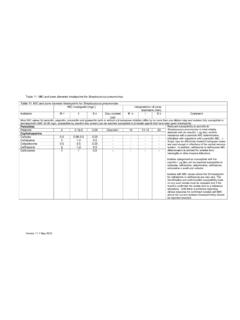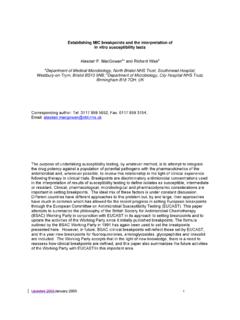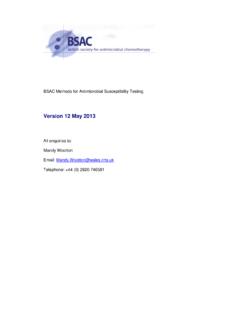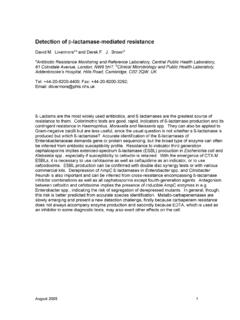Transcription of British Society for Antimicrobial Chemotherapy
1 British Society for Antimicrobial ChemotherapyBSAC to actively support the EUCAST Disc Diffusion Method for Antimicrobial Susceptibility Testing in preference to the current BSAC Disc Diffusion MethodFrom january 2016, the BSAC Standing Committee for Antimicrobial Susceptibility Testing, with the support of Council, will: Cease active support, maintainance and development of the BSAC disc diffusion method (queries from laboratories that continue to use the BSAC disc diffusion method will be supported during the transition period). Support UK laboratories in changing to the EUCAST (European Committee on Antimicrobial Susceptibility Testing) disc diffusion method should they wish to do this, through increased educational activities. Re-fashion the Residential Workshops to support a wider range of susceptibility testing and resistance detection methods and particularly support those using EUCAST methods.
2 Re-fashion the current User Days to cover a wider range of issues in susceptibility testing. Support EUCAST in the further development and maintenance of the EUCAST susceptibility testing methods. Support UK laboratories implementing EUCAST methods and having queries about the it was first developed and published in 2001, the BSAC standardized disc diffusion method of Antimicrobial susceptibility testing has been adopted by more than 175 laboratories across the UK. Annual updates have been published since the initial launch and version 14 of the method was published on the BSAC website in january , over the last five years there have been a number of developments in the field of Antimicrobial susceptibility testing which have rightly led to a re-evaluation of the position of the BSAC BSAC Standing Committee has been instrumental in supporting the development of EUCAST.
3 It signed-up to the EUCAST process for harmonised MIC breakpoint setting and EUCAST breakpoints have been incorporated into the BSAC guidelines. Although it was not part of the original EUCAST project, a standardised disc diffusion method (based on the Kirby-Bauer method using Mueller-Hinton agar) has been developed, resulting in a choice of two similar standardised disc diffusion methods (BSAC and EUCAST) that are calibrated against EUCAST breakpoints. The decision to support the EUCAST disc diffusion method in preference to the BSAC disc diffusion method has been taken for a number of reasons: The EUCAST method is a robust and standardised method. It is correlated to MICs performed according to the international standard method for testing Antimicrobial susceptibility (ISO20776-1:2006).
4 Many laboratories in the UK have already changed to using the EUCAST disc diffusion method. This leads to confusion between laboratories, particularly when reviewing NEQAS performance as the BSAC and EUCAST methods may perform differently for some challenging organisms. The EUCAST disc diffusion method has been developed to cover more Antimicrobial agent/organism combinations than the BSAC disc diffusion method. A few gaps remain ( Neisseria gonorrhoeae testing), but these are being actively developed. The fact that both BSAC and EUCAST methods are now used across the UK raises issues for the Standing Committee in delivery of relevant day-to-day support and also educational meetings and workshops. The EUCAST disc diffusion method is now the standard method used in most European countries and increasingly outside Europe.
5 This means that EUCAST can draw on a wider international pool of experts and laboratories (including those in the UK) for development and support Use of the EUCAST disc diffusion method would improve international standardisation and comparability and support resistance surveillance. EUCAST is recognised by the EMA for the setting of MIC breakpoints for new agents and is increasingly seen by drug developers as the standard-setting organisation for MIC breakpoints and disc diffusion further information please contact:Mandy Wootton (Secretary to the Standing Howe (Chair of the Standing informationChanges in version for appropriate agents to test3 Susceptibility testing tables:Enterobacteriaceae6 Acinetobacter maltophilia12 Link to guidance document on Stenotrophomonas maltophiliaLink to guidance document on vancomycin susceptibility testing in S.))
6 AureusLink to guidance document on dissociated resistance in staphylococciStreptococcus pneumoniae16 Enterococcus haemolytic streptococci20 Beta haemolytic streptococci21 Moraxella catarrhalis22 Neisseria gonorrhoeae24 Link to guidance document on N. gonorrhoeaeNeisseria meningitidis25 Haemophilus influenzae26 Pasteurella multocida28 Campylobacter anaerobes31 Clostridium difficile33 Gram-positive anaerobes34 Urinary Tract Infection comments36 Principals of reporting37 Further testing guidance documentsBurkholderia cepaciaLink to guidance document on Burkholderia cepacia groupHelicobacter pyloriLink to guidance document on Helicobacter pyloriListeria speciesLink to guidance document on Listeria speciesBrucella speciesLink to guidance document on Brucella speciesPink indicates breakpoints have restricted Society for Antimicrobial ChemotherapyStanding Committee on Susceptibility TestingVersion , 05-01-20151 version 14, january 2015 ChangesChanges (cells containing a change, a deletion or an addition)
7 From version 12 are marked yellowAddition of MIC breakpoints:CeftarolineAddition of diameter breakpoints:CeftarolineAddition of comments Any ceftaroline resistant isolates should be confirmed using an MIC method. Methicillin susceptible isolates can be reported susceptible to ceftaroline without further testing. British Society for Antimicrobial ChemotherapyStanding Committee on Susceptibility TestingEnterobacteriaceae2 Ciprofloxacin *Cefpodoxime (for ESBL screening)ErtapenemNitrofurantoinGentami cinCiprofloxacin or norfloxacinImipenem or meropenemCephalexinSuggestions for appropriate agents to include in routine Antimicrobial susceptibility testingThese suggestions are intended to indicate minimum sets of agents to test routinely in a diagnostic laboratory in order to give an For each organism group, suggestions are given of agents to test in systemic infection, or uncomplicated Urinary Tract Infection.
8 In a few infectionsUncomplicated UTIE nterobactericeaeAmpicillin or AmoxicillinAmpicillin or AmoxicillinCeftazidime plus cefotaxime or Amoxicillin-clavulanate[Cefpodoxime] (for ESBL screening)* It is recommended that an MIC is performed for invasive Salmonella isolatesOrganismsSystemic infectionsUncomplicated UTIP iperacillin-tazobactamTrimethoprim[Cefur oxime]AcinetobacterCiprofloxacinTreat as systemic as likely not uncomplicatedGentamicinImipenem or meropenemColistin *Amikacin **[Piperacillin-tazobactam]* MIC testing is required to establish colistin susceptibility** EUCAST rule "If intermediate or resistant to tobramycin and susceptible to gentamicin and amikacin, report amikacin as OrganismsSystemic infectionsUncomplicated UTIT reat as systemic as likely not uncomplicatedCeftazidime Ciprofloxacin GentamicinImipenem or meropenemPiperacillin-tazobactamColistin *[Tobramycin]**[Amikacin]
9 ** MIC testing is required to establish colistin susceptibility** May be appropriate according to local usePseudomonas sppAmikacin3 Suggestions for appropriate agents to include in routine Antimicrobial susceptibility testingTrimethoprimOrganismsSystemic infectionsUncomplicated UTIS taphylococciOxacillin or cefoxitinS. saprophyticusErythromycinCiprofloxacin or norfloxacinFusidic acid or rifampicinGentamicinGentamicinOxacillin or cefoxitinTetracyclineVancomycin *Vancomycin *NitrofurantoinMupirocinTrimethoprim[Lin ezolid]**[Daptomycin]**Treat as other species as systemic as likely not.[Penicillin]**[Teicoplanin]** MIC testing is required to establish vancomycin susceptibility** Recommended for testing in severe infectionOrganismsSystemic infectionsTetracyclineLevofloxacin or moxifloxacin[Vancomycin]OrganismsSystemi c infectionsUncomplicated UTIS.
10 PneumoniaePenicillin (oxacillin screen)ErythromycinLinezolidTrimethoprim Teicoplanin [additional not alternative to vancomycin]Ciprofloxacin or norfloxacinTeicoplanin [additional not alternative to vancomycin]Enterococcus sppAmpicillin or amoxicillinAmpicillin or amoxicillinGentamicin (high level screen)Vancomycin VancomycinNitrofurantoinUncomplicated UTIBeta-haemolytic streptococciErythromycin(Group B)PenicillinPenicillinTetracyclineNitrof urantoinOrganismsSystemic infections4 Suggestions for appropriate agents to include in routine Antimicrobial susceptibility testingTetracyclineTetracyclineTrimethop rimOrganismsSystemic infectionsM. catarrhalisAmpicillin or amoxicillin *Co-amoxiclavErythromycinCiprofloxacin [nalidixic acid to detect any quinolone resistance][Chloramphenicol][Cefotaxime] * Resistance to ampicillin by production of -lactamase (BRO-1/2 -lactamase) may be misidentified by disk diffusion technique and, because production is slow, may give weak results with in-vitro tests.









